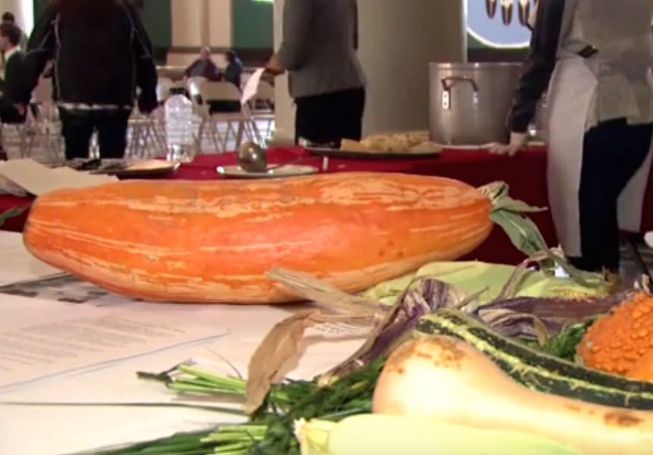Some Native Americans found squash seeds in a pot approximately 800 years old and revived the plant for the first time in centuries. The seeds from the large, bright orange squash have been distributed to native communities and to others, including some college students in Canada who grew a big, orange squash.

The revival of the giant squash comes at a time when scientists are trying to conserve the world’s precious and greatly diverse varieties and species of plant foods. In 2004, scientists from around the world opened a seed bank on a Norwegian island north of the Arctic Circle, where cold, dry conditions are right for preservation. Already there are hundreds of thousands of types of plant-food seeds in the vault.
“Many people don’t know this, but many of our traditional foods have been rendered extinct, largely due to modern agriculture’s industrial approach favoring a few cash crops over an entire variety of native fruits and vegetables,” the American Indian Center blog states. “Critics also suggest that genetically modified organisms are also killing native seeds. That’s why Gete Okosomin is something to celebrate. Every time someone successfully grows Gete Okosomin and saves the seeds, it’s a victory for our people.”

Vegetables and fruits available in modern grocery stores represent a small fraction of varieties extant, says Mother Nature Network . For the past century, food producers have put their efforts into growing varieties that give a high yield or can withstand the time and rough handling of transporting the produce a long distance. However, people around the world are working to preserve and propagate varieties of plants that used to be in the diet.
A Native American researcher in Vermont has been reproducing the horticulture that existed in his state before Europeans arrived
Frederick Wiseman, retired professor and expert on ethno-botany, spent years researching and working with the Maya civilization in Guatemala and Mexico. But for the past two decades he’s turned his attention to plants native to his homeland.
Dr. Wiseman now works to identify and preserve ancient seeds which were vital to the Abenaki Native Americans of northeastern North America. The history of the indigenous plants reveals a wealth of information that would otherwise have been lost in time. He has traced 26 different varieties, including squash, beans, corn, artichokes, ground cherries and tobacco, Ancient Origins reported in February 2015.
Fred Wiseman is not alone in his quest to preserve ancient seeds. Botanical researcher Elaine Solowey has nurtured more than 100 rare or near-extinct species back to life as part of a 10-year project to study plants and herbs used as ancient cures.
She has grown plants and herbs used in Tibetan, Chinese and biblical medicine, as well as traditional folk remedies from other cultures to see whether their effectiveness can be scientifically proved.

The Svalbard Global Seed Vault
To try to ensure planet Earth maintains its great heritage of edible plants, scientists years ago founded the Svalbard Global Seed Vault , the storage facility in Norway that preserves more than 860,000 food-crop seeds as of 2015. The operation is financed by the government of Norway and the Global Crop Diversity Trust , the mission of which is to conserve the planet’s crop diversity for the food security of current and future generations.
Plants range “from unique varieties of major African and Asian food staples such as maize, rice, wheat, cowpea, and sorghum to European and South American varieties of eggplant, lettuce, barley, and potato. In fact, the vault already holds the most diverse collection of food crop seeds in the world,” says CropTrust.org .

